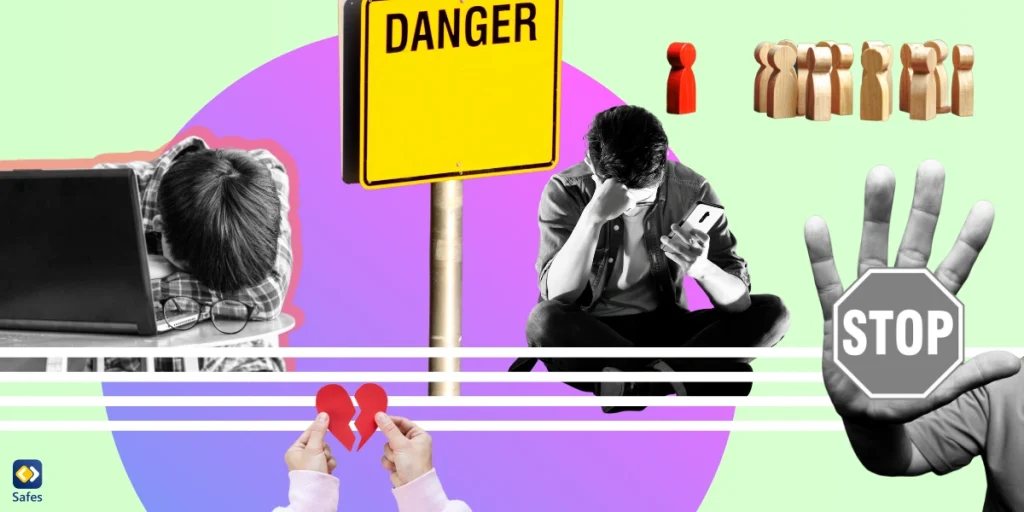In the digital age, TikTok has become one of the most popular social media platforms among young users. As a parent, it’s important to monitor your child’s online activities to ensure their safety. One challenge you might face is recovering deleted messages on TikTok. This guide will help you understand how to recover deleted TikTok messages and view deleted content.
Download and Start Your Free Trial of the Safes Parental Control App
Understanding TikTok and Its Dangers
TikTok allows users to send direct messages (DMs) to one another. These messages can include text, videos, and images, making communication on the platform versatile. However, like other messaging platforms, TikTok messages can be deleted by the sender or the receiver, making it challenging for parents to monitor conversations.
TikTok, like many social media platforms, has its dangers and its fun parts (there are many TikTok educational accounts, for example). These include exposure to inappropriate content, cyberbullying, and interaction with strangers. The platform’s algorithm can sometimes promote harmful content, and the messaging feature can be used to share such content privately. Though there are ways to keep kids safe on TikTok, understanding these dangers is the first step in safeguarding your child’s online experience.

Why Recover Deleted TikTok Messages?
There are several reasons why you might want to recover deleted TikTok messages:
- Ensuring Safety: As a parent, you need to ensure that your child is not exposed to inappropriate content or communicating with strangers who might have malicious intentions.
- Monitoring Bullying: Cyberbullying is a significant concern. Recovering deleted messages can help you identify if your child is a victim or perpetrator of bullying.
- Preventing Miscommunication: Sometimes, messages are deleted due to misunderstandings. Recovering them can help clarify any confusion. Sometimes kids hide TikTok which makes communicating the dangers of the platform more difficult for parents.
- Protecting Mental Health: Continuous monitoring can help you understand your child’s mental state and intervene if necessary.
How to View Deleted TikTok Messages
Currently, TikTok does not offer a native feature to view deleted messages directly. Though some TikTok trackers might help you monitor your child’s TikTok account, they generally don’t allow you to see deleted messages. However, there are several workarounds and methods you can try to recover or view these messages:
-
Check the TikTok Trash Folder
Many apps have a trash folder where deleted content is stored temporarily before being permanently removed. While TikTok does not explicitly have a “trash folder” for messages, you can check if any recently deleted content might still be recoverable.
-
Use Data Recovery Software
There are various third-party data recovery software options available that can help recover deleted messages on TikTok. These tools scan your device for deleted data and attempt to recover it. Ensure you use reputable software to avoid malware or data theft.
-
Check Your Linked Email or Phone
Sometimes, TikTok sends notifications of messages to your linked email or phone number. Check these notifications to see if you can find any information about the deleted messages.

How to Recover Deleted Messages on TikTok Android
If your child uses an Android device, follow these steps to recover deleted TikTok messages:
- Check Device Backups: If your device is set to automatically back up data, you might be able to restore deleted messages from a recent backup.
- Use Data Recovery Apps: Data recovery apps can help recover deleted messages. Install the app, follow the instructions, and scan your device for deleted TikTok messages.
- Contact TikTok Support: If you’re unable to recover the messages using the above methods, contact TikTok support for assistance. While they may not always be able to recover deleted messages, it’s worth a try.
How to Recover Deleted TikTok Messages on iPhone
For iPhone users, the process is slightly different:
- Check iCloud Backups: If your iPhone backs up data to iCloud, you might be able to restore deleted messages from a backup. Go to Settings > [Your Name] > iCloud > Manage Storage > Backups and see if there’s a recent backup that includes the TikTok messages.
- Use Data Recovery Software: Data recovery software can help recover deleted messages on iPhones. Follow the software instructions to scan your device and recover the messages.
- Reach Out to TikTok Support: As with Android, if other methods fail, contact TikTok support for help.
How to Unsend a Message on TikTok
Sometimes, instead of recovering deleted messages, you might want to unsend a message. TikTok allows users to delete messages they’ve sent, effectively “unsending” them. To unsend a message:
- Open the Chat: Navigate to the chat where the message was sent.
- Tap and Hold the Message: Tap and hold the message you want to delete.
- Select “Delete”: Choose the delete option from the menu that appears.
Using Safes Parental Control App
Monitoring and recovering deleted messages manually can be time-consuming and challenging. This is where a parental control app like Safes comes in handy. Safes allows you to monitor your child’s online activities, set screen time limits, and track their location. Here’s why you should consider using Safes:
- Comprehensive Monitoring: Safes gives you access to your child’s online activities across various platforms, including TikTok.
- Real-Time Alerts: Get notified of any suspicious activity, ensuring you can intervene promptly.
- User-Friendly Interface: The app is easy to use, making it simple for parents to navigate and monitor their child’s activities.
Conclusion
Recovering deleted TikTok messages can be a crucial step in ensuring your child’s safety online. While TikTok does not offer a direct way to view deleted messages, the methods outlined above can help you recover them. Additionally, using a parental control app like Safes can provide comprehensive monitoring and peace of mind. Remember, the key to keeping your child safe online is staying informed and proactive. You can download Safes for iOS, Android, Windows, and MacOS. Try out Safes’s free trial today!
Your Child’s Online Safety Starts Here
Every parent today needs a solution to manage screen time and keep their child safe online.
Without the right tools, digital risks and excessive screen time can impact children's well-being. Safes helps parents set healthy boundaries, monitor activity, and protect kids from online dangers—all with an easy-to-use app.
Take control of your child’s digital world. Learn more about Safes or download the app to start your free trial today!




